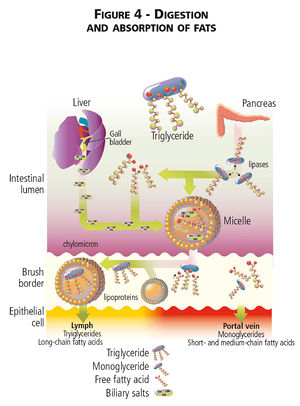Digestibility of Fat
Fat and fatty acid (FA) digestion begins in the stomach of both dogs and cats and involves coordination of the pancreas, gall bladder, and small intestine for optimal absorption.[1] In the stomach, gastric lipase cleaves triglycerides into free fatty acids (FFA). Once in the duodenal lumen, the FFAs stimulate secretion of cholecystokinin (CCK), which in turn stimulates gall bladder and pancreatic contraction. Pancreatic lipase and colipase further cleave FFAs, cholesterol and fat-soluble vitamins from the ingested fat, which are emulsified with bile salts from the gall bladder to form a mixed micelle. The mixed micelles are then absorbed into the jejunal enterocytes by passive diffusion (the primary mechanism of uptake) or carrier-mediated uptake, with specific binding proteins for cholesterol and long- and medium-chained FA chains. Resorption of bile salts by the jejunum is low, with the majority of reabsorption occurring in the ileum. Once in the enterocyte the FAs, cholesterol, and other phospholipids present are packaged into a lipoprotein rich compound called a chylomicron which is secreted into the intestinal lymphatic systems (lacteals). A smaller portion of dietary fat also passes directly into the portal circulation.
Apparent digestibility of fat can be affected by both animal and diet factors. Animal factors that can result in fat malabsorption include dysfunction in any of the organs responsible for fat digestion and absorption (e.g. stomach, pancreas, liver, and small intestine). Even in otherwise healthy animals, fat digestibility decreases with age in cats,[2] but remains relatively consistent in otherwise healthy older dogs.[3] Dietary fat from fresh meat and seed oils have a relatively high digestibility of approximately 95-99%,[1] which can decrease to 70-90% digestibility in commercial diets depending on processing[4][5] and type of fat used.[6] Shorter chain FA are more digestible than longer chains.[7] The presence of soluble fibres and starches can decrease fat digestibility, while insoluble fibres do not appear to significantly affect fat digestibility in dogs or cats.[8][9][10] Fat, especially polyunsaturated fatty acids (PUFA), is susceptible to oxidative damage and rancidity during processing and storage, which can adversely affect palatability of the diet. Prevention of rancidity requires addition of preservatives (i.e. antioxidants) to the diet; increased PUFA intake also increases the dietary requirement of vitamin E to prevent cellular oxidative damage.[11]
References
- ↑ 1.0 1.1 National Research Council (NRC). (2006) Fat and Fatty Acids. In Nutrient Requirements for Dogs and Cats. Washington, DC: National Academies Press p.86-87.
- ↑ Peachey SE, et al. (1999) The effect of ageing on nutrient digestibility by cats fed beef tallow-, sunflower oil- or olive oil-enriched diets. Growth Dev Ageing 1999:63:49-58.
- ↑ Sheffy BE, et al. (1985) Nutrition and metabolism of the geriatric dog. Cornell Vet 1985;75:324-347.
- ↑ Kerr KR, et al. (2012) Apparent total tract energy and macronutrient digestibility and fecal fermentative end-product concentrations of domestic cats fed extruded, raw beef-based, and cooked beef-based diets. J An Sci 2012;90:515-522.
- ↑ Huber TL, et al. (1986) Variation in digestibility of dry dog food with identical label guaranteed analyses, JAAHA 1986;22:571-575.
- ↑ Adams KL and Jensen AH. (1984) Comparative utilization of in-seed fats and the respective extracted fats by young pigs. J An Sci 1984;59:1557-1566.
- ↑ Cera KR, et al. (1990) Evaluation of various extracted vegetable oils, roasted soybean, medium-chain triglyceride and an animal-vegetable fat blend for postweaning swine. J An Sci 1990;68:2756.
- ↑ Burkhalter TM, et al. (2001) The ratio of insoluble to soluble fiber components in soybean hulls affects ileal and total-tract nutrient digestibilities and fecal characteristics of dogs. J Nutr 2001;131:1978-1985.
- ↑ Kienzle E, et al. (2001) Effect of cellulose on the digestibility of high starch versus high fat diets in dogs. JAPAN(Berl) 2001;85:174-185.
- ↑ Prola L, et al. (2010) Influence of cellulose fibre length on faecal quality, mineral excretion and nutrient digestibility in cat. JAPAN(Berl) 2010;94:362-367.
- ↑ Niza MM, et al. (2003) Feline pansteatitis revisited: hazards of unbalanced home-made diets. J Feline Med Surg 2003;5:271-277.
| This article was: Date reviewed: 19 May 2015 |
| Endorsed by WALTHAM®, a leading authority in companion animal nutrition and wellbeing for over 50 years and the science institute for Mars Petcare. |
